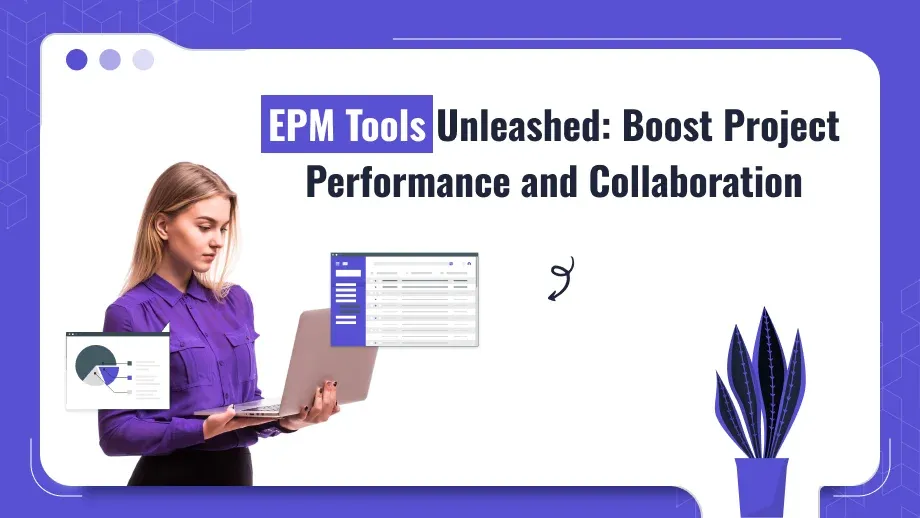
In today’s business climate The success of any company is dependent on its capacity to efficiently manage and improve the performance of employees. Enterprise Performance Management (EPM) tools instruments have become essential to HR managers and professionals in allowing them to monitor as well as evaluate and enhance the performance of employees in real-time. These tools are not just helpful to manage performance, but they are also instrumental in ensuring that individual contribution is aligned with the strategic objectives of the company.
This blog will examine the value of EPM tools, their most important attributes, the various examples of their EPM systems for performance management as well as the obstacles organizations must overcome when they implement them, and the ways they can contribute to the development of a positive workplace culture.
What Are EPM Tools?
EPM tools are advanced software tools designed to assist organisations streamline the process for measuring and improving the performance of employees. They are often incorporated with software for enterprise project planning software that offer features that permit managers to define clear goals to track progress, offer immediate feedback and assist with periodic performance reviews.
The purpose of these tools is to provide a systematic system for managing performance that aligns employee contribution to the company’s goals and ultimately ensuring results for business. Thanks to advances in technology, Planning Tools and Techniques have been adapted to include diverse features that increase their efficiency and accessibility.
Understanding EPM Software
What is EPM? Enterprise Performance Management EPM software comprises a collection of procedures and tools to aid organizations in managing their performance and meet the strategic goals. This entails budgeting, forecasting reports and analysing results related to employees’ performance. With the help of enterprise project management software, businesses are able to effectively monitor and control the various elements of efficiency in a seamless way.
Why Are EPM Tools Important?
1. Enhancing Employee Engagement
One of the major positives of EPM tools is their capacity to increase employee satisfaction. In the event that employees receive frequent feedback, and are able to see clearly to their targets for performance and objectives, they are more engaged with their job. This increases their engagement, satisfaction, motivation, and satisfaction at work.
In fact, new research found that companies employing EPM to provide constant feedback scored significantly better levels of employee engagement than the ones that rely solely on annual reviews of performance. Employees who are engaged are more likely to do more than and contribute positively to a company’s overall success.
2. Promoting Accountability
EPM tools foster accountability, allowing employees to be accountable for their objectives and results. The tools offer transparency when it comes to the tracking of performance, which allows employees to understand their contribution to the business.
If employees know the fact that their work is being assessed, they’re more likely to remain engaged and focused on the tasks at hand. In particular, if employees consistently track their performance against established metrics by using an EPM tools, they’re more likely to see the areas where they’re not performing and then take the necessary steps to make improvements.
3. Facilitating Continuous Feedback
Traditional reviews of performance usually occur each year. This could lead to misalignment or missing opportunities to improve. EPM tools regular feedback and allows the employees and their managers to engage in periodic check-ins as well as discussions on their performance.
The ongoing dialog helps to address problems quickly and keep employees focused. Businesses that use periodic feedback cycles have an improvement in their performance and as well stronger connections between management and their team members. Moving away from annual review in favor of continuous feedback is crucial in creating a culture that encourages collaborative and open communication.
4. Aligning Goals with Business Objectives
EPM tools help in ensuring that each employee’s goals are in line with the larger goals of the organization. With the help of specific, measured objectives and constantly monitoring the performances, employers can be sure that every employee’s contribution is directly to the success of the business.
If, for instance, an EPM team is focusing on promoting brand recognition, EPM can help set specific goals for the engagement of social media campaigns, reach of the campaign, and lead generation. This will ensure that all employees are focused on the same goals. The alignment of the team not only improves the individual’s performance, but it also helps propel the company towards the goals of its strategic plan.
5. Data-Driven Decision Making
EPM tools gather valuable information regarding employee performance. They provide insight that can help managerial and HR decision-making. Data-driven approaches help determine the top performers, skills gap, and needs for training which allows organizations to make educated decisions regarding promotions, rewards, as well as personal development. Furthermore when aligning these data-driven insights to a structured Project Charter Template organisations can make sure that the roles of employees and their responsibilities are clearly identified, contributing to the overall project’s success.
In the case of data, for example, if it suggests that a certain team is consistently meeting its objectives however another team is struggling in achieving its objectives, managers can examine the root cause and then make specific changes, by way of more training, allocation of resources or even process modifications. Through the use of project enterprise management tools, companies are able to take data-driven decision making, encouraging a culture of accountability and excellence in performance.
Kickstart Your Projects – Maximize Efficiency with EPM Tools!
Define objectives, track performance, and drive project success from day one using powerful EPM tools.
Key Features of EPM Tools
Effectively assist companies in controlling employees’ performance, EPM tools typically include several essential attributes:
1. Goal Setting and Tracking
EPM allows employees and managers to define clear, quantifiable objectives. They can track these goals in time, providing insight to progress as well as conformity with corporate objectives. In the case of an example, a for enterprise project management tool could enable the sales manager to define goals for the team’s quarterly period participant and observe their progress over the course of the period, making changes as required.
This ensures everyone’s attention is at the same goal and improves overall productivity and efficiency.
2. Real-Time Feedback
Real-time feedback enables managers to give immediate feedback regarding performance, encouraging an open dialogue and allows employees to adapt their behavior as they need. The instant feedback helps to reinforce positive behaviours and addresses problems before they become a problem.
In the case of an example, if you notice that a supervisory member is experiencing difficulty in completing an assignment, they may give immediate assistance and feedback instead of waiting for the next performance evaluation. The proactive way to provide feedback is a great way to create a culture that encourages continuous improvement.
3. Performance Reviews and Evaluations
EPM help with structured reviews for performance which makes it easier for managers to review the performance of employees consistently. The evaluations are able to be tailored to incorporate specific criteria and skills specific to the position.
A standardized process for evaluation can ensure objectivity and fairness when it comes to performance evaluations essential to employee morale and retention. As an example, companies are able to evaluate the performance of managers in relation to their leadership abilities along with team dynamics as well as the achievement of goals.
4. 360-Degree Feedback
Most EPM offer the 360-degree feedback option which allows employees to obtain feedback from supervisors, peers and their subordinates. The holistic approach to results helps ensure that feedback is fair and thorough.
360-degree feedback may be especially beneficial for leaders that evaluate performance on a range of dimensions including collaboration, communication, or the ability to solve problems. The feature does not just enhance feedback, but it also creates an environment that encourages collaborative improvement.
5. Analytics and Reporting
EPM provides analytics and report capabilities that allow HR personnel and managers to evaluate patterns in performance and to identify opportunities for improvements. The data-driven method aids in making strategic decisions.
In this way, they could analyze the performance data to find out the departments or teams that have the highest performance and those that require support. This allows the implementation of targeted actions. Analytics can help organizations adopt data-driven strategies to improve efficiency management.
6. Integration With Other HR Systems
EPM typically integrates with HR systems that are not integrated, for example, payroll management india systems as well as talent management and Learning management software. The integration simplifies the process and increases the accuracy of data throughout the entire organization.
Through ensuring that the performance information is standardized and readily accessible, companies are able to make better informed choices regarding the management of talent and their development. Integration creates a unified HR system that helps employees advancement and the success of an organization.
Overcoming Challenges in EPM Tool Implementation
Although EPM provides significant advantages, companies may encounter difficulties when they implement EPM, and they can be a challenge to implement. Below are a few common issues and ways to conquer these challenges:
1. Resistance to Change
Managers and employees may be hesitant about using a brand the latest EPM because of the lack of knowledge or a fear of scrutiny. To overcome this issue, businesses need to communicate the benefits of these tools in a clear manner as well as provide support for training in order to ensure an easy process of transition.
Sharing success stories of early adopters may also inspire others to accept the changes. In creating a positive environment in which information about the tools could be exchanged will make the transition easier.
2. Data Privacy Concerns
When it comes to the gathering of the performance of employees, they may be concerned about privacy concerns and the way their data is utilized. The company must create clear guidelines on data privacy, and then communicate these to employees so that they can build trust.
It is vital to make clear the fact that performance data is employed to help employees develop and not as punitive actions. The transparency of data use increases confidence when it comes to the process of project management procedure.
3. Inconsistent Usage
To allow EPM to work it is essential that they are used regularly throughout the company. Managers must emphasize how important it is to use EPM and promote an environment of frequent evaluation and setting goals.
Implementing standard operating procedures making use of the tool can to ensure accountability and consistency. Training and reinforcement regularly helps to maintain the significance of these devices in daily activities.
4. Ensuring User Adoption
Adoption by users is vital to the effectiveness of any EPM tool’s deployment. Companies should ensure that they provide adequate instruction and assistance to make sure that users feel confident using the software. Involving employees from the beginning of the process, and asking for their opinions can further foster an ownership mindset and increase usage.
5. Measuring Effectiveness
Additionally, employers should develop measures to assess the efficacy of EPM. Continuously reviewing the effects of these tools on employees’ satisfaction, engagement, and satisfaction, will allow organizations to assess if their investment in EPM will produce the expected results.
Best Practices for Implementing EPM Tools
In order to maximize the efficiency of EPM companies should take into consideration these best practices
1. Define Clear Objectives
Before adopting the use of an EPM tool, businesses must establish clear goals for the goals they want to accomplish. This can determine the choice of the best tool to make sure that it is in line with the goals of the organization.
2. Involve Employees in the Process
Participating employees in the choice and use of EPM will help to increase the acceptance and buy-in of employees. Inquiring feedback from employees helps ensure that the software fulfills their needs, and also enhances the experience for users.
3. Provide Training and Support
The provision of training for employees and managers will ensure everyone is aware of how to utilize the EPM efficiently. Continuous support must also be offered to resolve any issues or problems that come up.
4. Encourage Regular Check-Ins
It is important for managers to hold periodic check-ins with teammates to talk about the progress made and to provide feedback. Discussions like these help keep teams aligned and help employees stay determined to achieve their objectives.
5. Utilize Data for Continuous Improvement
Companies should periodically analyze the data gathered by EPM to find patterns, areas of improvement and potential opportunities to develop their professional skills. Utilizing this information can aid organizations in making informed choices concerning potential talent EPM project management and development.
6. Foster a Culture of Feedback
Establishing an organization culture that is supportive of feedback could dramatically improve the efficacy of EPM. Promote open communication and create rules that make employees confident sharing their views regarding their development and performance.
Conclusion
EPM are crucial to driving results for organizations and improving the engagement of employees. Through effective tracking and monitoring performances, businesses can build an atmosphere of alignment, accountability and continual advancement.
Making the investment in the best EPM helps businesses streamline their procedures, aid in employee advancement, and ultimately reach the goals they set for themselves. Take advantage of the tools available today and experience their transformative effects on the organization you work for.
Utilizing the enterprise software project management as well as integrating it into existing systems, businesses are able to create an integrated process for managing their performance. This unified approach does not just increase productivity, but also guarantees that Project Objectives are clear and aligned to employee performance. By aligning these goals with wider corporate goals ensures sustainable expansion and sustainable success.





